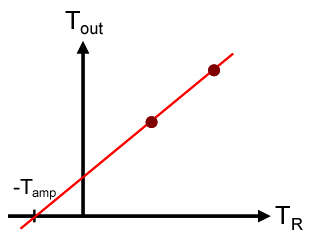Y-factor on:
[Wikipedia]
[Google]
[Amazon]
The Y-factor method is a widely used technique for measuring the gain and  Consider a
Consider a
noise temperature
In electronics, noise temperature is one way of expressing the level of available noise power introduced by a component or source. (This is to be distinguished from Temperature Noise in Thermodynamics or Principal Interferrometric Analysis Over C ...
of an amplifier
An amplifier, electronic amplifier or (informally) amp is an electronic device that can increase the magnitude of a signal (a time-varying voltage or current). It may increase the power significantly, or its main effect may be to boost t ...
. It is based on the Johnson–Nyquist noise
Johnson–Nyquist noise (thermal noise, Johnson noise, or Nyquist noise) is the electronic noise generated by the thermal agitation of the charge carriers (usually the electrons) inside an electrical conductor at equilibrium, which happens reg ...
of a resistor at two different, known temperatures.
 Consider a
Consider a microwave
Microwave is a form of electromagnetic radiation with wavelengths ranging from about one meter to one millimeter corresponding to frequencies between 300 MHz and 300 GHz respectively. Different sources define different frequency ra ...
amplifier with a 50-ohm
Ohm (symbol Ω) is a unit of electrical resistance named after Georg Ohm.
Ohm or OHM may also refer to:
People
* Georg Ohm (1789–1854), German physicist and namesake of the term ''ohm''
* Germán Ohm (born 1936), Mexican boxer
* Jörg Ohm (b ...
impedance with a 50-ohm resistor connected to the amplifier input. If the resistor is at a physical temperature
Temperature is a physical quantity that expresses quantitatively the perceptions of hotness and coldness. Temperature is measurement, measured with a thermometer.
Thermometers are calibrated in various Conversion of units of temperature, temp ...
''T''R, then the Johnson–Nyquist noise power coupled to the amplifier input is ''P''J = ''k''B''T''R''B'', where ''k''B is Boltzmann’s constant, and ''B'' is the bandwidth. The noise power at the output of the amplifier (i.e. the noise power coupled to an impedance-matched load that is connected to the amplifier output) is ''P''out = ''Gk''B(''T''R + ''T''amp)''B'', where ''G'' is the amplifier power gain, and ''T''amp is the amplifier noise temperature
In electronics, noise temperature is one way of expressing the level of available noise power introduced by a component or source. (This is to be distinguished from Temperature Noise in Thermodynamics or Principal Interferrometric Analysis Over C ...
. In the Y-factor technique, ''P''out is measured for two different, known values of ''T''R. ''P''out is then converted to an effective temperature ''T''out (in units of kelvin
The kelvin, symbol K, is the primary unit of temperature in the International System of Units (SI), used alongside its prefixed forms and the degree Celsius. It is named after the Belfast-born and University of Glasgow-based engineer and phy ...
) by dividing by ''k''B and the measurement bandwidth ''B''. The two values of ''T''out are then plotted as a function of ''T''R (also in units of kelvin), and a line is fit to these points (see figure). The slope of this line is equal to the amplifier power gain. The ''x'' intercept of the line is equal to the negative of the amplifier noise temperature −''T''amp in kelvins. The amplifier noise temperature can also be determined from the ''y'' intercept, which is equal to ''T''amp multiplied by the gain.
References
{{reflist Microwave technology Radio technology Electrical engineering Electronic engineering